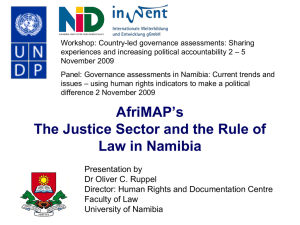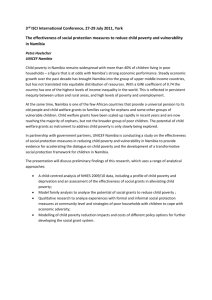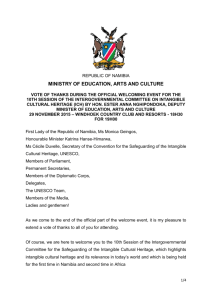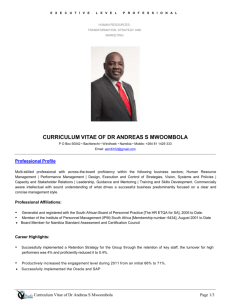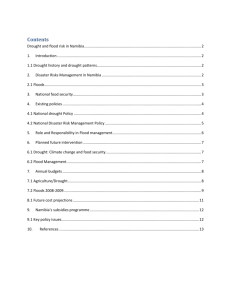Why Drought and flood management are important
advertisement
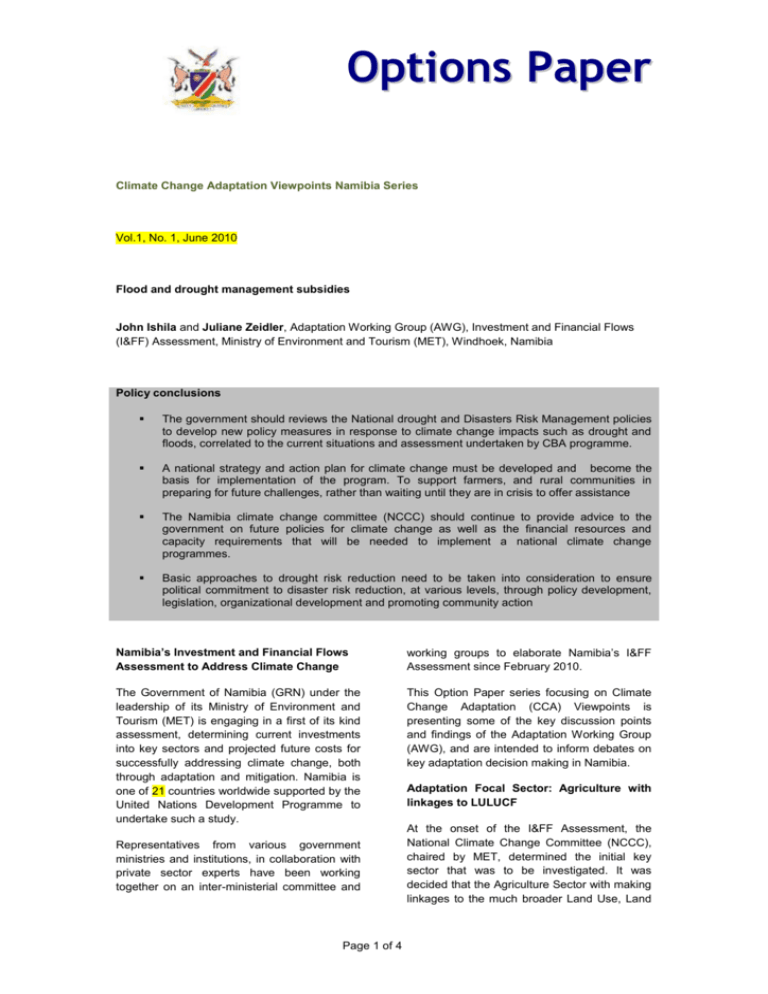
Options Paper Climate Change Adaptation Viewpoints Namibia Series Vol.1, No. 1, June 2010 Flood and drought management subsidies John Ishila and Juliane Zeidler, Adaptation Working Group (AWG), Investment and Financial Flows (I&FF) Assessment, Ministry of Environment and Tourism (MET), Windhoek, Namibia Policy conclusions The government should reviews the National drought and Disasters Risk Management policies to develop new policy measures in response to climate change impacts such as drought and floods, correlated to the current situations and assessment undertaken by CBA programme. A national strategy and action plan for climate change must be developed and become the basis for implementation of the program. To support farmers, and rural communities in preparing for future challenges, rather than waiting until they are in crisis to offer assistance The Namibia climate change committee (NCCC) should continue to provide advice to the government on future policies for climate change as well as the financial resources and capacity requirements that will be needed to implement a national climate change programmes. Basic approaches to drought risk reduction need to be taken into consideration to ensure political commitment to disaster risk reduction, at various levels, through policy development, legislation, organizational development and promoting community action Namibia’s Investment and Financial Flows Assessment to Address Climate Change working groups to elaborate Namibia’s I&FF Assessment since February 2010. The Government of Namibia (GRN) under the leadership of its Ministry of Environment and Tourism (MET) is engaging in a first of its kind assessment, determining current investments into key sectors and projected future costs for successfully addressing climate change, both through adaptation and mitigation. Namibia is one of 21 countries worldwide supported by the United Nations Development Programme to undertake such a study. This Option Paper series focusing on Climate Change Adaptation (CCA) Viewpoints is presenting some of the key discussion points and findings of the Adaptation Working Group (AWG), and are intended to inform debates on key adaptation decision making in Namibia. Representatives from various government ministries and institutions, in collaboration with private sector experts have been working together on an inter-ministerial committee and Page 1 of 4 Adaptation Focal Sector: Agriculture with linkages to LULUCF At the onset of the I&FF Assessment, the National Climate Change Committee (NCCC), chaired by MET, determined the initial key sector that was to be investigated. It was decided that the Agriculture Sector with making linkages to the much broader Land Use, Land Use Change and Forestry (LULUCF) Sector should be the focus of the initial investigations. Whereas the full I&FF Adaptation Assessment Report is available at http://xxxx, and other volumes in this Option Paper series are providing succinct summaries thereof, this current CCA Viewpoint is presenting policy relevant research information on a selected case study that was undertaken by AWG members to enrich the Assessment. The following case study topics are presented in the series: (i) Mahangu – a suitable dryland crop? (ii) Cotton & Rice – food alternatives under changing climatic conditions? (iii) Aquaculture – is there a real potential? (iv) Indigenous livestock – what is the value? (v) Game and wildlife – better adapted land and resource uses? (vi) Flood and drought subsidies (vii) Weather forecasting and decision making tools region, Ohangwena, Omusati, Oshana and small portion of Oshikoto Region. Since 2008, heavy rains falls in northern and north eastern Namibia, compounded by severe rainfall in the neighbouring countries of Angola and Zambia, have led to flooding and left the majority of the rural poor in the country homeless and loss their property. The floods affected 350,000 people (nearly 17% of the country’s population), (Ocha, 2009). Referring to the 2006 same situation also happen when Heavy rains in central Namibia caused three rivers in the Mariental constituency catchments areas to swell up, raising the level of the Hardap Dam to its capacity level. Due to risk of collapse of the dam by the pressure of water, Nam Water opened the gates of the dam. The water was released in the ‘Fish River’ situated between Hardap Dam and the town of Mariental. The river flooded Mariental, displacing 2,100 people (330 households), submerging 122 houses, 80 businesses, (DREF, 2006). Role and Responsibility in drought Flood management in Namibia Full report available This Options Paper is based on work undertaken in support of a full-length report, Investment and Financial Flows for Addressing Adaptation to Climate Change in Namibia. The report was prepared by the interministerial Adaptation Working Group (AWG) and can be obtained from the Directorate of Environmental Affairs (DEA), Ministry of Environment and Tourism (MET) in Windhoek, Namibia. Contact: Uazamo Kaura or Reagan Chunga, Tel: + 264 -61-284-2111 E-mail: uazamo@met.na or sibanga@gmail.com It can be downloaded from http://xxx Why Drought and flood management are important to Namibia’s Investment and Financial Flows Assessment to Address Climate Change In Namibia, events like droughts and floods occur more frequently due to the increase in temperature which is predicted in the whole country. Large amount of rainfall is expected to occur in a short period time of rain season, due to the predicted increase of late summer convective rainfall over Namibia. Therefore this might have implications for the frequency of floods in northern regions, mainly Caprivi Page 2 of 4 Directorate of Emergency Management (DEM) in the Office of Prime Minister (OPM) and Regional Emergency Management Units (REMUs) and other NGOs organization in Namibia are playing major role in addressing and responding to the issues of disaster risk management. In line with the decentralization policy the intention of the National Drought Policy was to establish emergency management structures at constituency and village levels. Although REMUS engages with traditional leaders in their regions to respond to drought and floods, these structures at constituency and village levels are in reality and not in actually in place. Planning and future intervention The Government of Namibia has implemented and continues to implement a set of measures to counteract the effects of climate change (flood and Drought) and rising food prices on the national food security situation of the country. According to NEPRU report on Namibia Agriculture and Future Scenarios for Southern Africa Country its stating that, Government has already direct actions in place and planned one in process, to address the issue of food security in the country. Namibia is also aim of creating systems and capacities requirements for long-term and comprehensive climate change adaptation, through Namibia Africa Adaptation Project (NAM-AAP), (UNDP, 2010). It will basically focus on strengthening planning mechanisms to help Namibia cope with climate change vulnerabilities, particularly flood and drought risks. What are the key challenges – and what is needed for strong adaptation? Adaptation, Namibia received insufficient early warning information from the Zambezi River Basin Authority and from the Okavango River Basin Commission and collaboration with these two Regional Commissions should be strengthened in the future. Training and awareness, Poor capacity on improving community knowledge’s on anticipatory and responsive adaptation strategies to ensure sustainability. Government expenditure investments budgets. and flood response, it comes when the government spend the total amount of N$12,169,340.62 in response to the heavy floods that affected largely the eastern and western regions in Namibia. In addition the OPM also received the amount of N$5,134,388.00 from local and international donor, (DEM, 2008). Responding to the flood of 2009, the government expenditure was based on a total of N$104,199,005 budget. Government expenditure on flood response 2009 projected The 2003/4 drought cost the government about N$ 275 Million in provision of emergency relief (IIED, 2007). In 2008-9 a government spend the amount of N$6.8 million, on subsidy programme consisting of both input (seed and fertilizer) and service (ploughing and weeding) to communal farmers in dry land crop regions. There was no separate Government budget for responding to the flood disaster in the past on Page 3 of 4 Source: Directorate Emergency Management. 2009 Due to MRGHRD short to medium and long term future plans which was drafted last year, a total of N$ 578,337,083.00 is required to the projected interventions to reduce vulnerabilities of flood disaster in the flood prone areas in urban areas of Oshakati and Ongwediva towns. 1. References DEM, 2008. Report on Nation Response. Floods Disaster. OPM. Windhoek. Namibia. DEM, 2009. Report on Nation Response on Floods Disaster, Government expenditure on flood response. Windhoek , Namibia. FTS, 2009. OCHA Report, Funding to Namibia Flash Appeal against the original requirements. United Nation. New York. New York. Retrieved from, www.humanitarianappeal.net. Accessed on the 6th April 2010. M. Froystad et al, 2008. NEPRU Working Paper No. 113. Agriculture: Future Scenarios for Southern Africa Country Briefing-Namibia. Windhoek. Namibia. OCHA, 2009. Namibia Revision Flash Appeal. Humanitarian Consequences and need analysis. United Nation. New York. Retrieved from, www.humanitarianappeal.net. Accessed on the 6th April 2010. Sweet, R.J. 1997. Towards sustainable range management in communal areas. Proceedings of 7th Congress of the Agricultural Scientific Society of Namibia, Windhoek. Sweet, R.J. 1998. Guidelines for livestock development and sustainable range management in NOLIDEP pilot communities. Northern Regions Livestock Development Project (NOLIDEP), Windhoek. Page 4 of 4

